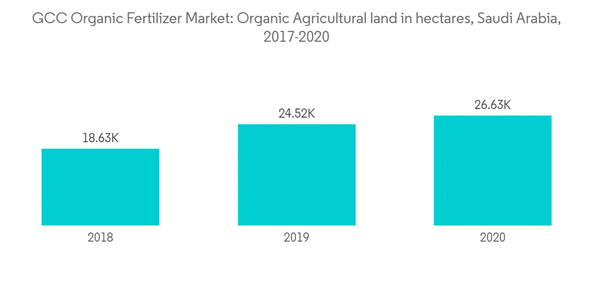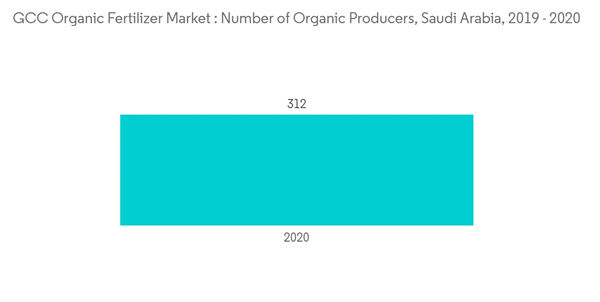Key Highlights
- The increasing focus on organic farming practices and the high availability of raw materials for fertilizer production are the two major factors driving the GCC organic fertilizer market. Following the pandemic, there is a greater awareness of healthy food among the region's consumers, resulting in an increase in demand for organic food.This, in turn, increased organic food sales in the major countries. According to the Dubai Chamber of Commerce and Industry, organic food sales reached USD 34 million in the United Arab Emirates in 2020, 8.7% higher than in 2019.
- Along with this, the availability of raw materials and increasing interest in organic farming practices are boosting the organic fertilizer sector. Additionally, the ongoing state-led programs for the development of organic fertilizers implemented by the central and state governments and the huge expansions of harvest areas for organic agriculture are also boosting the market studied. For instance, according to the FiBL statistics, the organic agriculture land in the UAE was 5,419 hectares in 2020, which showed an increase from 4,642 hectares in 2019.
Moreover, the increased investments in organic farming startups in the major countries are also supporting the increased use of organic fertilizers in the GCC region. For instance, in June 2021, Red Sea Farms, a Saudi Arabia-based organic farming start-up, received funding of USD 10 million from a group of Saudi and UAE investors. Such investments in the organic farming ecosystem directly impact the growth of organic fertilizers in the region. Therefore, the increase in health consciousness coupled with the increased area under farming are the factors driving the growth of the organic fertilizer markets in the GCC countries.
GCC Organic Fertilizer Market Trends
Increasing Focus on Organic Farming Practices
The rising demand for organic products is booming due to increased awareness among consumers and rising incomes, along with improved farming practices that make organic yields more robust. As a result, the increasing demand for organic food in the area under organic farming is increasing in a positive way. For instance, according to the Research Institute of Organic Agriculture (FiBL) Statistics, the total farmland under organic farming in Saudi Arabia was 24.5 thousand ha in 2017, which reached 26.6 thousand ha by 2020. The increase in organic farmland increases the usage of organic fertilizers, thereby contributing to market growth.Along with this, in the GCC countries, Saudi Arabia is the largest market and has a functioning organic sector. Organic farming is seen as a viable development strategy for the agricultural sector. The Saudi government has started taking steps to support more eco-friendly farming systems to cope with the growing demand for healthy food products that also help safeguard scarce water and soil resources. For instance, the investment of SAR 750 million (USD 200 million) by the Saudi Arabian government as a part of its strategy for innovation in agriculture increased the number of organic farms by 28% in 2021. The government's strategies help Saudi Arabia achieve its overall goal of boosting the organic market and strengthening the sector’s development.
Moreover, the GCC nations recognize the potential of organic agriculture, and they have been taking steps to support an eco-friendly farming system, boosting the demand for organic fertilizers. Additionally, the increase in health-conscious people is driving the need for increased production. The sector's development is further supported by the need for sufficient production, innovative marketing strategies, and an institutional and legal framework. Therefore, the demand for organic products is increasing due to the increased focus of governments on the organic sector, which will parallelly aid the growth of the organic fertilizer market during the forecast period.
Saudi Arabia Dominates the Market
Saudi Arabia has the most arable land among all the countries in the GCC region, though the arable land is only 1.63% of the total land area. The percentage of organic land in total arable land is growing year over year. For example, the percentage of organic agricultural land will be higher in 2020 than it was in 2019.Additionally, there are significant developments taking place in Saudi Arabia in the organic sector. On the production side, the number of producers is also increasing, which shows a positive impact on the organic fertilizer market's growth. For instance, the number of producers in 2019 was 244, which has increased to 312 in 2020. The increase in the percentage of organic farmland along with the number of producers is giving wings to the organic fertilizer market in Saudi Arabia.Along with this, the intensity of consuming healthy and nutritious foods is increasing. This is driven by rapid urbanization and high disposable incomes. So, they are looking forward to healthier foods with fewer chemical residues. Thus, the country is expected to witness growth in the demand for organic fruits and vegetables. The production of organic fruits and vegetables is not sufficient to meet the local demand and is highly dependent on imports. Therefore, it is planning to reduce the import burden on food. Thus, the need to enhance organic productivity is pushing the demand for organic fertilizers, which helps the market grow.
Furthermore, Saudi Arabia’s major urban areas are the main consumption centers for organic products. Most of the specialized organic shops and supermarkets with organic sections are located in some of the country’s largest cities (Riyadh, Dammam, Al Khobar, and Jeddah). Such factors are leading to an increased need for organic production and creating demand for organic fertilizers. For this reason, the Saudi Arabian government is taking initiatives to adopt sustainable agricultural practices, thereby boosting the organic fertilizer market in the region. The increase in the adoption rate of hydroponics and the encouragement of attempts to convert desert land into arable farmland by the government are helping the market grow. Therefore, the increase in the percentage of organic agricultural land along with the organic food demand will cater to the organic fertilizer market's growth in the coming years.
GCC Organic Fertilizer Market Competitor Analysis
The GCC organic fertilizer market is concentrated, with a few players, like Al-Akhawain, Al Yahar Fertilizers, RNZ International FZCO, Al Madeena Organic Fertilizers, and Abu Dhabi Fertilizer Industries Co. WLL, accounting for the majority of the market share in the region. Companies are collaborating with technology and other firms to ensure sustainable product innovation in the future. Companies operating in this region are primarily focusing on improving their production facilities and distribution networks.Additional benefits of purchasing the report:
- The market estimate (ME) sheet in Excel format
- 3 months of analyst support
This product will be delivered within 2 business days.
Table of Contents
Companies Mentioned (Partial List)
A selection of companies mentioned in this report includes, but is not limited to:
- RNZ International FZCO
- Abu Dhabi Fertilizer Industries Co. WLL
- Emirates Bio Fertilizers Factory
- Arab Qatari Agricultural Production Company
- Al-Akhawain
- Al Yahar Organic Fertilizers Factory
- Nabat agriculture & Trading Co.
- Debbane Saikali Group
- Heera Organic Fertilizer










